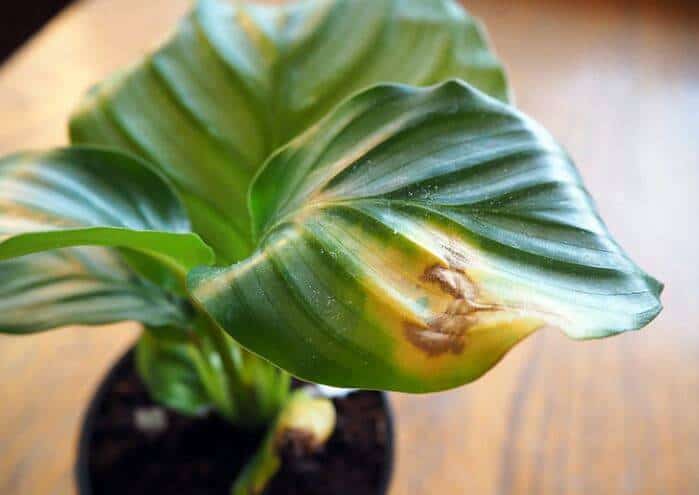Last Updated on January 7, 2023 by a Friendly Gardener
While there may be approximately 50 species of Prayer plants, there are only a few commonly found in nurseries. A popular houseplant that boasts striking colorful foliage, it finds its natural habitat in tropical rainforests in the Americas. Belonging to the Marantaceae family, they do need a certain amount of care to protect and nurture their stunning foliage.
Yellowing leaves on the Prayer plant are a clear sign of distress that can be caused by a variety of problems. Identifying the problem will permit you to remedy the situation to protect the health of your plant, and you should intervene as soon as you notice yellowing foliage.
Why Is My Prayer Plant Turning Yellow?
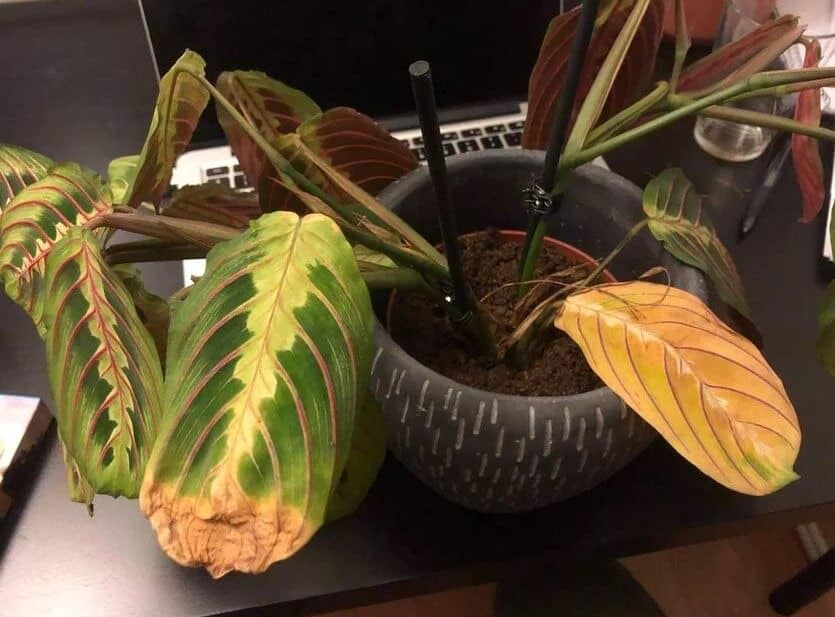
Here are some of the more common reasons that Prayer plants develop yellow leaves.
Overwatering
Overwatering is one of the principal reasons for failing houseplants. Even if you have a clay pot with several drainage holes and a great growing medium, as a concerned pet parent, you may be tempted to overwater. The problem for this family of plants is that the soil bed can quickly become waterlogged and soggy creating the perfect environment for root rot to set in. Foliage can quickly begin to yellow.
One of the challenges to cultivating Prayer plants is getting your watering schedule correct. While a Prayer plant will require a bit more water than many other popular houseplants, it should not be swimming. Check your plant at least twice weekly for moisture content. If the pot still feels a bit weighted and the topsoil is damp, wait to water your plant.
Inadequate Humidity Levels
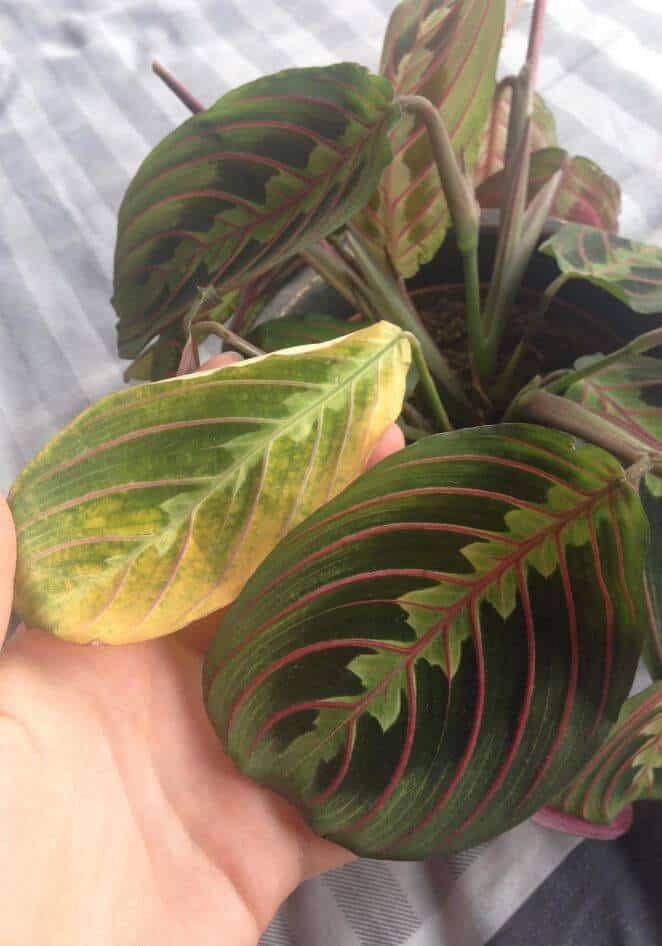
If you live in an arid climate or make use of centralized heating and air conditioning, the indoor air may be too dry for your plant and consequently, it will suffer. The edges and the tips of the leaves may begin to yellow or turn brown. As a tropical plant, a Prayer plant is hyper-sensitive to low humidity levels. Indoor environments should register humidity levels between 40% and 60%. Consider acquiring a humidity meter known as a hygrometer to verify if your levels are insufficient.
If the indoor humidity is too low, apply one of these techniques to adjust levels:
- Use a space humidifier
- Group several houseplants near each other
- Use a pebble tray beneath your plant’s container
- Mist your plant’s leaves regularly
- Cultivate your plant in a room with naturally higher humidity like a bathroom
Improper Soil Bed Drainage
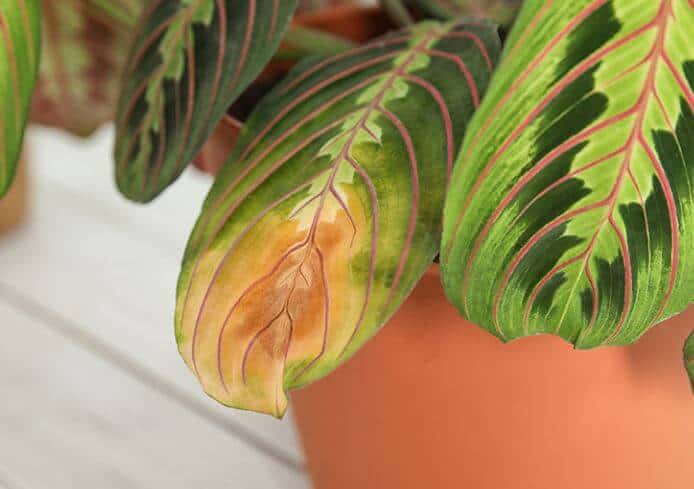
Even if this houseplant originates in the tropics and enjoys moisture, it cannot survive without proper drainage. Waterlogged soil will impede oxygen from arriving at root systems, suffocating the plant. This can cause foliage to turn yellow and die. Also, avoid letting your plant pot sit in a saucer of water as this can contribute to soggy soil conditions as water will cease to drain. This can prove to be fatal.
When you water your plant, set it in a tub or sink and allow all the excess water to drain out. Do not return your plant to its location until drainage has finished.
If drainage seems to be the problem, you may have the wrong kind of soil blend. Ideally, the Prayer plant should be potted with peat moss or peat and coir-based blend. This will ensure adequate moisture retention and good drainage.
Select an appropriate container. If plastic, it will need several drainage holes, otherwise opt for a terra cotta or clay pot to aid in wicking out excess moisture.
A Cold Climate
The Prayer plant thrives in tropical climates, so it will not do well in the cold and will die if left in temperatures below freezing. Even if your plant’s location does not have temps that drop below freezing, it will be sensitive to cooler environments in any case.
Ideally, your Prayer plant needs temperatures that always measure above 55°F. Temps that are colder can cause leaves to yellow. Also, keep in mind that if you purchase a Prayer plant in the winter, it may suffer during transport if the weather is too cold.
A Prayer Plant with an Iron Deficiency
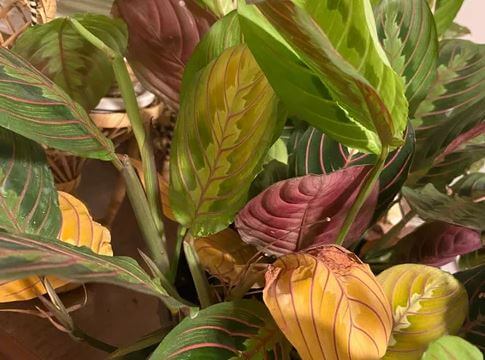
Prayer Plant yellow leaves can also be due to an iron deficiency. If you can rule out cold temperatures, overwatering, poor drainage, and low humidity, consider an iron deficiency. Some experts even suggest that an alkaline soil bed can inhibit the plant’s capacity to absorb iron by the plant. If the soil pH is high, your plant may be unable to get the necessary iron to produce its chlorophyll. This will negatively influence a plant’s ability to photosynthesize and nourish itself. Apply an appropriate liquid iron supplement or consider changing the soil blend.
Diseases and Pests
Both diseases and pests can cause a Prayer plant to develop yellow foliage. Prayer plant yellow spots on leaves can be indicative of Cucumber Mosaic Virus while Helminthosporium leaf spots will cause spots that are characterized by yellow halos. Spider mites can also create yellow stippling on Prayer plant leaves.
Spider mites can be sprayed off with water jets and then the plant should be treated with insecticidal soap or Neem oil.
There is no known remedy for Cucumber Mosaic Virus. You should destroy your plant to prevent it from spreading to other houseplants.
Helminthosporium leaf spot is a fungal infection. Infected leaves should be removed and destroyed.
Communicating Distress
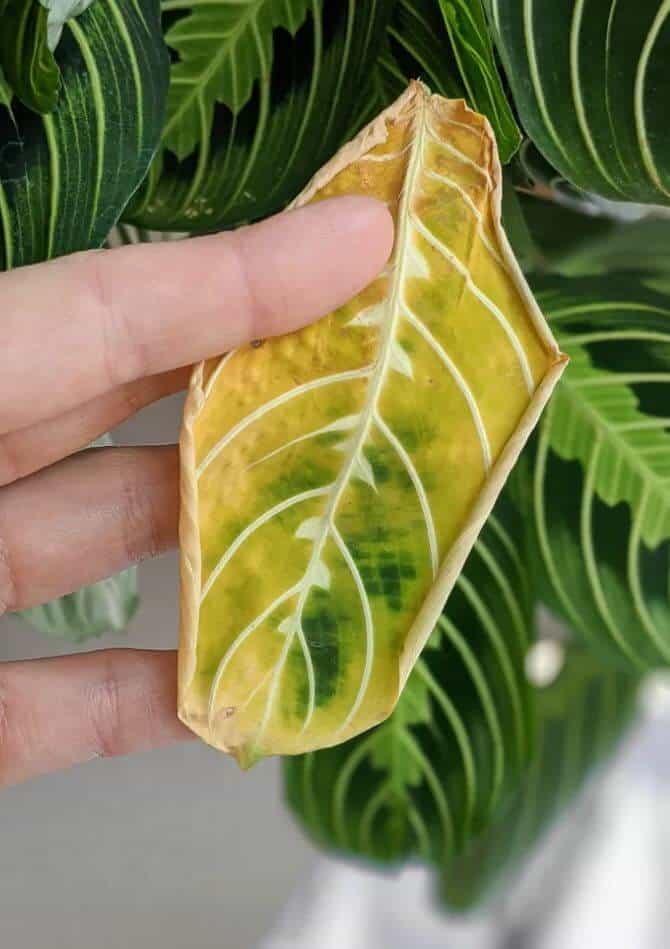
When your Prayer plant develops yellow leaves, it is a cry for help. Something is wrong and is causing your plant to suffer. Remove yellow leaves. Ensure adequate environmental temperatures and humidity levels. Check your soil pH and drainage as well as your watering schedule. Finally, look for evidence of pest infestations or disease or consider an iron deficiency and take steps to resolve whatever problem is affecting your Prayer plant.

